
Concept explainers
(a)
Interpretation: Among the given terms aldoses, ketoses, hexoses and aldohexoses, the term that is applied to both
Concept introduction: The simplest hydrolyzed form that is obtained from the carbohydrates is known as monosaccharide. Monosaccharide is categorized into two types. The first type of monosaccharide is aldoses and the second type of monosaccharide is ketoses. Aldoses sugar possesses
Monosaccharides are also classified on the basis of the number of carbon atoms present in it. For example, the sugar that contains five carbon atoms is known as pentoses sugar and the sugar that contains six carbon atoms is known as hexoses sugar.
(a)
Answer to Problem 18.62EP
The monosaccharide,
Explanation of Solution
The monosaccharide,

The second sugar,

(b)
Interpretation: Among the given terms aldoses, ketoses, hexoses and aldohexoses, the term that is applied to both
Concept introduction: The simplest hydrolyzed form that is obtained from the carbohydrates is known as monosaccharide. Monosaccharide is categorized into two types. The first type of monosaccharide is aldoses and the second type of monosaccharide is ketoses. Aldoses sugar possesses aldehyde as a functional group and the ketoses sugar possesses ketone as a functional group.
Monosaccharides are also classified on the basis of the number of carbon atoms present in it. For example, the sugar that contains five carbon atoms is known as pentoses sugar and the sugar that contains six carbon atoms is known as hexoses sugar.
(b)
Answer to Problem 18.62EP
The monosaccharide,
Explanation of Solution
The monosaccharide,
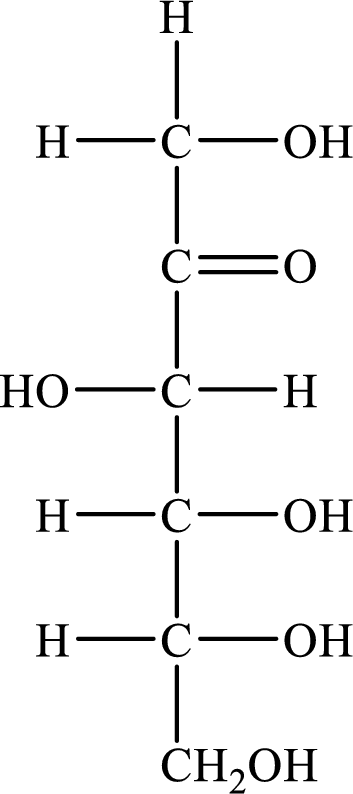
The second sugar,
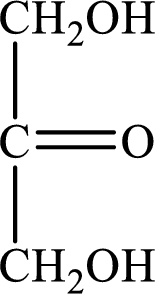
(c)
Interpretation: Among the given terms aldoses, ketoses, hexoses and aldohexoses, the term that is applied to both
Concept introduction: The simplest hydrolyzed form that is obtained from the carbohydrates is known as monosaccharide. Monosaccharide is categorized into two types. The first type of monosaccharide is aldoses and the second type of monosaccharide is ketoses. Aldoses sugar possesses aldehyde as a functional group and the ketoses sugar possesses ketone as a functional group.
Monosaccharides are also classified on the basis of the number of carbon atoms present in it. For example, the sugar that contains five carbon atoms is known as pentoses sugar and the sugar that contains six carbon atoms is known as hexoses sugar.
(c)
Answer to Problem 18.62EP
The monosaccharide,
Explanation of Solution
The monosaccharide,

The second sugar,
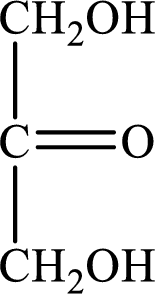
(d)
Interpretation: Among the given terms aldoses, ketoses, hexoses and aldohexoses, the term that is applied to both
Concept introduction: The simplest hydrolyzed form that is obtained from the carbohydrates is known as monosaccharide. Monosaccharide is categorized into two types. The first type of monosaccharide is aldoses and the second type of monosaccharide is ketoses. Aldoses sugar possesses aldehyde as a functional group and the ketoses sugar possesses ketone as a functional group.
Monosaccharides are also classified on the basis of the number of carbon atoms present in it. For example, the sugar that contains five carbon atoms is known as pentoses sugar and the sugar that contains six carbon atoms is known as hexoses sugar.
(d)
Answer to Problem 18.62EP
The monosaccharide,
Explanation of Solution
The monosaccharide,
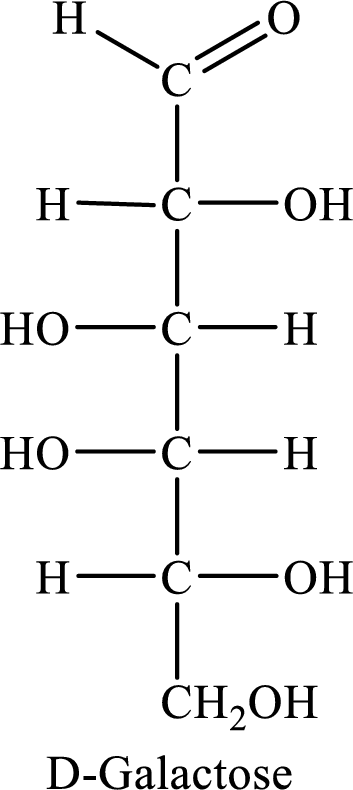
The second sugar,
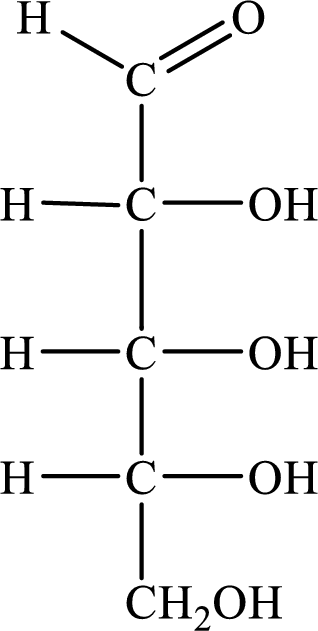
Want to see more full solutions like this?
Chapter 18 Solutions
EBK GENERAL, ORGANIC, AND BIOLOGICAL CH
- Define the following terms: a. lactose b. maltose c. homoglycans d. heteroglycans e. starcharrow_forwardMatch the following sugars with their corresponding descriptions. A. Esculin J. 1. aldonitol G. rhamnose K cellobiose D. Melibiose E. saccharose C. raffinose H. trehalose F. Glucose B. Lactose Arabinose A. a pentose alcohol. B. a disaccharide consisting of glucose and galactose units linked by 3(1-4) glycosidic bond C. a trisaccharide consisting of galactose, fructose and glucose D. a disaccharide consisting of glucose and galactose units linked by a(1-6) glycosidic bond E. a disaccharide consisting of glucose and fructose linked by a1-32 glycosidic bond F. a monosaccharide under aldohexoses G. deoxymannose H. a disaccharide consisting of 2 glucose units linked by a(1-1) glycosidic bond I. glucoside of esculetin. J. a monosaccharide under aldopentoses K. a disaccharide consisting of 2 glucose units linked by B(1-4) glycosidic bondarrow_forwardDraw the Fischer projection formula for each sugar and give the importance/use of each. 1. D- glyceraldehyde 2. D- erythrose 3. D- ribose 4. D- deoxyribose 5. D- glucose 6. D- galactose 7. D- fructose 8. D- ribulosearrow_forward
- A student performed Benedict’s test on fructose, maltose, lactose, and sucrose to determine if they are reducing or non-reducing sugars. a. Draw out the products of those carbohydrates/sugars that can be oxidized and explain why those sugars are so easily oxidized. Please provide only those sugars that are reducing sugars.arrow_forwardDefine the following terms: a. reducing sugar b. alditol c. enediol d. acetal e. ketalarrow_forwardThese are the options: Given the choices of carbohydrates in the following list and provide the type of carbohydrates that match with the given descriptions A. Glucose B. Fructose C. Galactose D. Mannose E. Ribose F. Xylose G. Xylulose H. Glucosamine I. Maltose J. Sucrose K. Lactose L. Trehalose M. Amylose N. Amylopectin O. Cellulose P. Agarose Q. Glycosaminoglycanarrow_forward
- Listed below are descriptions that may belong to amylose, amylopectin, both, or it may not belong to either. Write A if it describes amylose, B if it describes amylopectin, AB if the statement applies to both, or O if it doesn’t apply to either. 1. Its monosaccharides are bound by at least one α-1,4-glycosidic bond. 2. It contains α-1,6-glycosidic bonds. 3. It can be broken down by the enzyme α-amylase. 4. A polysaccharide made up of gulose. 5. It can form a double helix.arrow_forwardReferring to the structures in Figures 28.4 and 28.5, classify each pair of compounds as enantiomers, epimers, diastereomers but not epimers, or constitutional isomers of each other. a. D-allose and L-allose d. D-mannose and D-fructose b. D-altrose and D-gulose c. D-galactose and D-talose e. D-fructose and D-sorbose f. L-sorbose and L-tagatosearrow_forwardDescribe the structural similarities and differences of the following pairs. Identify which of these is a structural isomer, and how to identify structural isomers. a. Glucose and Mannose b. Galactose and Fructose c. Ribulose and Xylulose d. ribose and glucosearrow_forward
- Identify whether each monosaccharide is an aldose or a ketose. Н НО Н Н НО- CHO ОН H -ОН ОН CH2OH CH2OH H CH₂OH Н НО Н CHO ОН CHO H -ОН CH₂OH н-с ОН CH2OH Н Н Н Н· CH2OH C=0 ОН CH2OH ... CHO ОН ОН ОН CH2OH Но Н Н Н CH2OH c=0 -Н -ОН CH2OH CH2OH О ОН ОН CH2OHarrow_forwardAll of the following are examples of monounsaturated fatty acids except A. Palmitoleic acid B. Oleic acid C. Elaidic acid D. Linoleic acidarrow_forwardAll monosaccharides are either ketoses or aldoses. Select one: a. False b. Truearrow_forward
 Human Anatomy & Physiology (11th Edition)BiologyISBN:9780134580999Author:Elaine N. Marieb, Katja N. HoehnPublisher:PEARSON
Human Anatomy & Physiology (11th Edition)BiologyISBN:9780134580999Author:Elaine N. Marieb, Katja N. HoehnPublisher:PEARSON Biology 2eBiologyISBN:9781947172517Author:Matthew Douglas, Jung Choi, Mary Ann ClarkPublisher:OpenStax
Biology 2eBiologyISBN:9781947172517Author:Matthew Douglas, Jung Choi, Mary Ann ClarkPublisher:OpenStax Anatomy & PhysiologyBiologyISBN:9781259398629Author:McKinley, Michael P., O'loughlin, Valerie Dean, Bidle, Theresa StouterPublisher:Mcgraw Hill Education,
Anatomy & PhysiologyBiologyISBN:9781259398629Author:McKinley, Michael P., O'loughlin, Valerie Dean, Bidle, Theresa StouterPublisher:Mcgraw Hill Education, Molecular Biology of the Cell (Sixth Edition)BiologyISBN:9780815344322Author:Bruce Alberts, Alexander D. Johnson, Julian Lewis, David Morgan, Martin Raff, Keith Roberts, Peter WalterPublisher:W. W. Norton & Company
Molecular Biology of the Cell (Sixth Edition)BiologyISBN:9780815344322Author:Bruce Alberts, Alexander D. Johnson, Julian Lewis, David Morgan, Martin Raff, Keith Roberts, Peter WalterPublisher:W. W. Norton & Company Laboratory Manual For Human Anatomy & PhysiologyBiologyISBN:9781260159363Author:Martin, Terry R., Prentice-craver, CynthiaPublisher:McGraw-Hill Publishing Co.
Laboratory Manual For Human Anatomy & PhysiologyBiologyISBN:9781260159363Author:Martin, Terry R., Prentice-craver, CynthiaPublisher:McGraw-Hill Publishing Co. Inquiry Into Life (16th Edition)BiologyISBN:9781260231700Author:Sylvia S. Mader, Michael WindelspechtPublisher:McGraw Hill Education
Inquiry Into Life (16th Edition)BiologyISBN:9781260231700Author:Sylvia S. Mader, Michael WindelspechtPublisher:McGraw Hill Education





